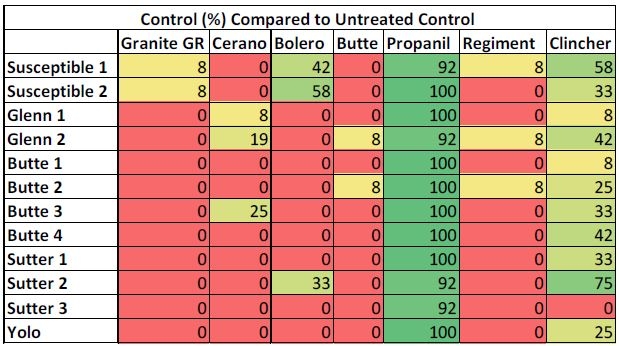Watergrass
We are having more and more difficulties controlling watergrass over the past 20 or so years. We know that as of the early 2000s, we had found multiple-herbicide resistant late watergrass (also known as mimic), as well as multiple-herbicide resistant barnyardgrass. For early watergrass, we now have resistant biotypes (to thiobencarb), with none recorded as being multiple-herbicide resistant.
In 2017, two rice fields were identified with an unknown watergrass biotype (or species) that looked very different than the three main known species that infest California rice fields (late watergrass, early watergrass, and barnyardgrass). Both fields had extensive infestations, which were uncontrolled by repeated herbicide applications. The lack of control was coupled with outward characteristics that were not immediately identifiable to one of the known species. After extensive attempts at identification at both the UC Davis Herbarium, and even with the assistance of two Echinochloa experts at two other universities, we were unable to conclusively identify the species. In 2018, 10 more fields were identified, and samples were collected and screened for herbicide susceptibility in 2020. Rates are below (Table 1).
| Trade Name | Active Ingredient | Rate |
| Cerano® | clomazone | 12 lb a-1 |
| Bolero® | thiobencarb | 23.3 lb a-1 |
| Butte® | benzobicyclon + halosulfuron | 7.5 lb a-1 |
| Granite GR® | penoxsulam | 15 lb a-1 |
| Clincher® | cyhalofop | 15 fl oz a-1 |
| Regiment® | bispyribac-sodium | 0.57 oz a-1 |
| SuperWham® | propanil | 6 qt a-1 |
Results
10 of the 10 unknown watergrass samples were not controlled at 14 Days After Treatment (DAT) (less than 50% by biomass, in comparison to the untreated controls) by Granite GR® or Butte® (Table 2). 9 of the 10 samples were not controlled by Bolero®, and 6 of the 10 were not controlled by Cerano®. SuperWham®, Regiment®, and Clincher® controlled 10 of 10 samples (at least 50% control).
For the number of living plants remaining at 14 DAT, 10 of the 10 unknown watergrass samples were not controlled by Granite GR®, Butte®, Bolero®, or Cerano® (50% or more of the plants remained) (Table 3). 10 of the 10 samples were not controlled by Regiment®, 9 of 10 were not controlled by Clincher®. SuperWham® controlled 10 of 10 samples (at least 50% control).
Conclusion
The results of this screening closely align with what growers are seeing in the field: the unidentified watergrass is escaping early-season granular control and is then difficult or impossible to control with late-season herbicide applications. Foliar applications in the greenhouse were highly effective (by percent biomass reduction), but since the greenhouse application was conducted at an early timing (1.5 leaf stage of grass), it is possible that later applications in the field may be less effective. Furthermore, some of the herbicides, in particular, Regiment® and Clincher®, although showing biomass reduction at this early stage application (at least 60% in most cases), did not show 100% control of individual plants, which could recover later in the season. Further testing in the field or greenhouse is necessary to determine if that is the case. Again, this matches closely with grower anecdotal evidence in the field, where the unidentified watergrass appears to recover from applications of both Regiment® and Clincher®.
For growers, this preliminary screening implies that control of this new biotype/species will need to be prioritized early in the season, with an aim at overwhelming the plants' ability to metabolize the herbicides, as well as utilizing alternative modes of action. Some possible treatments (note: these have not been field-tested and could cause phytotoxicity) could be: a stale seedbed using a non-selective herbicide; pre-plant Prowl H2O® (pendimethalin) followed by post-emergent herbicide applications; pre-plant Abolish® (thiobencarb) followed by Cerano® or Butte® or Granite GR®; Cerano® followed by Butte® or Bolero® or Granite GR®; or Butte® followed by Granite GR® or Bolero®. There is still a strong likelihood that a follow-up application may still be required later in the season, even with these early-season applications.
Research with this unidentified species or biotype is ongoing, and another larger set of samples was collected in 2020. This larger set will also be subjected to a screening in the greenhouse, and results will be reported in 2021-2022.
Weedy Rice
Although we did not confirm any new biotypes in 2021 (data pending), we want to remain vigilant, as we continue to find new fields and acreage every year. For the latest, most up-to-date reports, please make sure to visit the California Weedy Rice website (caweedyrice.com) website, and subscribe to our Weedy Rice Email Updates (on the CA Weedy Rice website).
If you currently have weedy rice infested acreage, we recommend doing the following in 2021:
- If possible, fallow or crop rotate (with less water available this year, fallowing may be a good option)
- Use a pre-plant stale seedbed (flush the field, wait approximately 7-10 days for weedy rice to
emerge, then spray with glyphosate or other non-selective herbicide - Once weedy rice can be identified:
a. Hand rogue (make sure to pull plants completely out of the field and dispose of them)
b. If plants have fully headed, cut panicles off into bucket to avoid seed shattering
c. Spot spray (SUPPRESS® can be applied to a drained rice field, with a backpack sprayer).
Spray at rice early boot stage. See UC Rice Blog for more specific information. NOTE: no
other herbicides are labeled for spot spraying in California rice
In 2021, we would ask that growers and PCA's continue to give us a call if they suspect they have weedy rice in their fields. Please contact Whitney Brim-DeForest (wbrimdeforest@ucanr.edu) (Sutter, Yuba, Placer, and Sacramento), Luis Espino (laespino@ucanr.edu) (Butte, Glenn), or Michelle Leinfelder-Miles (mmleinfeldermiles@ucanr.edu) (San Joaquin). For Colusa or Yolo, contact either Whitney or Luis.
Author - County Director, Sutter and Yuba Counties and CE Rice and Wild Rice Advisor

